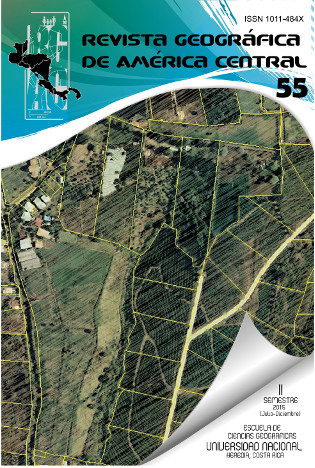CONSTRUCTION AND GEOGRAPHIC SETTING OF SPATIAL DATA OF DRINKING WATER SUPPLY AND SANITATION –AYA, IN COSTA RICA
DOI:
https://doi.org/10.15359/rgac.2-55.5Keywords:
Aqueducts, sanitation systems, infrastructure, Geographic Information Systems, factAbstract
The document presents the process and results of the project “Construction and Geographical Setting of Spatial Data of Drinking Water and Sanitation Systems of the Costa Rican Institute of Aqueducts and Sewers” performed by using Geographic Information Systems. It also presents details on how to organize territorial information regarding water and sewer infrastructure, as well as the methods used in the construction and spatial setting of the data that belong to intermediate and rural (peripheral) cities in Costa Rica. Furthermore, it presents the results obtained from the project, and their use in different technical and operational fields.
References
AERODIVA- TERRA XXI. (2014). Productos generados en la consultoría para la construcción y ajuste geográfico de datos espaciales de los sistemas de agua potable y saneamiento para el Instituto Costarricense de Acueductos y Alcantarillados. Madrid, España.
Barrantes-Echeverría, R. (2002). Investigación, un camino al conocimiento, un enfoque cualitativo y cuantitativo. San José, C.R.: EUNED.
Buzai, G. D. (2011). Geografía y Sistemas de Información Geográfica (Evolución teórico-metodológica hacia campos emergentes): Conferencia Magistral XIII EGAL Costa Rica 2011. Universidad Nacional de Luján, Programa de Estudios Geográficos, Argentina.
Cervera, B. y Rodríguez, J. (2008). Captura de información alfanumérica. México: Alfaomega.
Durant, M., Lévy, J., y Retaillé, D. (1992). Le monde, espaces et Systemes, Preses de la Fondation Nacionale des sciencies Politiques et Dalloz. París, Francia.
ESRI (Enviromental Systems Research Institute), ArcGIS Resources. (2015). La importancia del control de calidad. California, EE.UU. Recuperado de http://resources.arcgis.com/es/communities/datareviewer/01rp00000006000000.htm Instituto Costarricense de Acueductos y Alcantarillados (AyA). (2010). Datos sobre sistemas periféricos de las regiones Brunca, Chorotega, Central Oeste, Pacífico Central, Huetar Atlántica. Subgerencia de Sistemas Periféricos, Pavas, Costa Rica.
Instituto Costarricense de Acueductos y Alcantarillados (AyA) Dirección de Desarrollo Físico. (2014). Datos generados en la consultoría para la construcción y ajuste geográfico de datos espaciales de los sistemas de agua potable y saneamiento para el Instituto Costarricense de Acueductos y Alcantarillados. Pavas, Costa Rica.
Instituto Tecnológico de Costa Rica. (2008). Atlas cantonal digital. Cartago, Costa Rica: Instituto Tecnológico de Costa Rica
Jones, C. (1997). Geographical information systems and computer cartography. Harlow, Longman. Moreno, A. (2008). Sistemas y análisis de la información geográfica: manual de autoaprendizaje con ArcGIS. México: Alfaomega Grupo Editor. Rodríguez, J. (2008). El modelo de datos vectorial: características y formatos. México: Alfaomega. Somarribas, L. (2008). Hacia una geografía de redes: un nuevo paradigma de análisis espacial alternativo al enfoque regional. Revista Geográfica de América Central, 41, 25-52.
Solano, M., Timothy, H. y Morera, C. (1993). Sistemas de Información Geográfica (SIG) como herramienta para el análisis espacial de los recursos hídricos. Universidad Nacional de Costa Rica, Escuela de Ciencias Geográficas, Revista Geográfica de América Central, 27, 123-135.
Downloads
Published
How to Cite
Issue
Section
License
Proposed policy for journals offering Open Access
Authors publishing their works in the Journal acknowledge and agree to the following terms:
a) Authors retain the copyrights to their works and guarantee the Journal the right to be the first to publish their works, under the Creative Commons License Attribution-NonCommercial-ShareAlike 4.0 International, CC BY-NC-SA 4.0 International (https://creativecommons.org/licenses/by-nc-sa/4.0/deed.es), which allows others to share works upon complying with the acknowledgment of authorship and mention of the Journal as the original publisher of the work.
b) Authors are permitted to separately establish additional agreements for the non-exclusive distribution of the official edition of the work published in the Journal (for example, authors may desire to place the work in an institutional repository or incorporate it into a book that is to published elsewhere) so long they acknowledgment to recognize the Journal as the original publisher. The aforementioned additional agreements must respect the terms of the non-profit character and sharing philosophy of the original license (CC BY-NC-SA 4.0 International, https://creativecommons.org/licenses/by-nc-sa/4.0/deed.es).
c) Authors are encouraged to archive the post-print or editor/PDF version in Open Access repositories.






 REVGEO is licensed under https://creativecommons.org/licenses/by-nc-sa/4.0/deed.es
REVGEO is licensed under https://creativecommons.org/licenses/by-nc-sa/4.0/deed.es
.svg_4.png)

_(1).png)
_(1)_(1)_(1)_1.png)
(2)(1)(1)(1).png)
